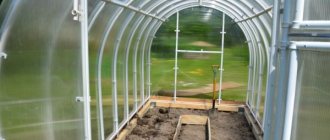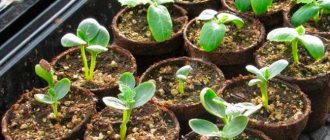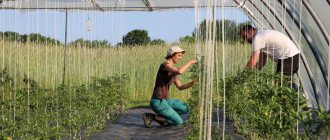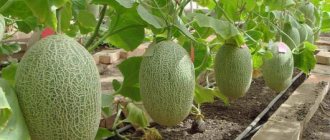2.5
(4)
Among the crops grown in the greenhouse, watermelon takes pride of place. It is cultivated in a greenhouse not on a production scale. Agricultural technology in this case also differs from the method of growing in open ground. The greenhouse method will allow you to get a harvest of sweet berries not only in the southern regions, but also in Siberia. The main thing is to create the necessary conditions for the plant. One of the important points is proper gartering of watermelons. In this article we will tell you how to tie up watermelons in a greenhouse and pay attention to the intricacies of harvesting.
The nuances of growing watermelons in greenhouses
Tie watermelons in a greenhouse to increase crop yield.
A summer resident must meet certain requirements in order for watermelons to bear fruit in a greenhouse:
- choose a variety with a minimum ripening period and low fruit weight;
- plant watermelons in a greenhouse only using seedlings;
- properly prepare greenhouse beds;
- accurately maintain the timing of planting watermelons in greenhouse soil;
- carefully follow the requirements for caring for watermelons in greenhouses.
The agricultural technology for growing watermelon in a greenhouse is not particularly complicated, but it is necessary to tie up the fruits.
Garter of whips
In the greenhouse, watermelons form lashes up to 10 m long, the weight of the fruit reaches 2–3 kg. Plants are fixed on trellises. The support can be either purchased or made independently.
Garter rules:
- Watermelons are formed into one stem, completely removing shoots without ovaries. The remaining branches are pinched.
- The number of fruits must be normalized; no more than 4–6 ovaries are left on one plant.
- The lashes are tied to the support when the height of the plant reaches 1 meter.
- It is recommended to lay the lower part of the stem on the ground and sprinkle it with soil so that the vine can receive more nutrition by growing additional roots.
With this organization of the garter, it will be possible to avoid excessive plant density and achieve rational use of the greenhouse area. Caring for tied plants is much easier.
Types of trellises used
In order to properly tie up plants, arched trellises are best suited. They are installed along the entire greenhouse. The number of trellises depends on the number of plants grown. Arched trellises can be purchased or homemade.
They can be made from metal-plastic pipes or fittings. The installation must be carried out before the watermelon seedlings are planted in the greenhouse. The design must be reliable: the support will bear the load from the entire vegetative mass, including fruits.
Arches are convenient because one watermelon on each side is tied to one support, which means the trellis can easily support the weight of fruit-bearing plants.
It is permissible to install a U-shaped trellis, placing it along the wall of the greenhouse. The support can be made of side wooden or metal pillars. The crossbar is made from timber under the ceiling of the greenhouse. If the structure is long, it can be reinforced with 1–2 additional supports or crossbars in the middle.
In the future, a strong twine or rope is tied to the crossbar opposite each plant - the lashes will be tied to it.
Due to the large weight of the loaded trellis, it is necessary to securely fasten the support pillars, digging them 50–60 cm into the ground. For greater stability, the base of the supports can be concreted.
Garter materials
Watermelon stems cannot cling to the trellis on their own, so they need to be tied up. For this purpose, twine, soft fabric ribbons, and special fasteners are used:
- The twine should not be too thin, otherwise after tying it will begin to dig into the tissue of the shoots, damaging them. Pathogenic microflora can easily penetrate inside through wounds. In addition, tissue injury is stress for the plant.
- The fabric should be thin and dry quickly. Rags are often used as garter material, cut into strips 2 cm wide and 20–25 cm long. If possible, you can use old nylon tights or stockings.
- Fasteners (clips) for garters are usually made of plastic. You can buy them where gardening supplies are sold. They can also be found in the Fixe-Price chain of stores. The devices are similar in appearance to clothespins and come in different sizes. Sometimes one set includes both large and small clips. With their help, you can tie up all the plants in the greenhouse at once in a few minutes.
- An advanced option is to use a stapler (tapener) to tie up plants. It comes complete with staples and nylon tape. Using the device, you can quickly tie up the lashes of watermelons. The price of staplers starts from 1,500 rubles, so it’s worth first assessing the feasibility of such a purchase. If there are a lot of plantings on the site that require garter, such an acquisition makes sense.
You should not tie watermelons to the trellis with thin wire or fishing line: they can easily injure and pinch the lashes, which will impede the access of nutrients to the fruit.
Choosing a greenhouse for growing watermelons
You can grow watermelons in greenhouses from:
- polycarbonate;
- window frames (used);
- film coating.
Requirements for a room for growing watermelons:
- The height varies from 1.7 m to 2 m. It is not recommended to install the greenhouse lower or higher. Watermelon is a climbing plant, so it must have enough space to grow.
- The greenhouse is prepared for growing watermelons in early spring. Inspect for structural integrity violations or breakdowns. Necessary precautions in case of frost or sudden cold snap.
- In the northern regions, the arrangement of warm ridges is mandatory. This protects the heat-loving crop from overcooling the root system.
- Greenhouses with additional heating devices are convenient for growing watermelons. In this case, temperature control is simplified.
- A separate greenhouse is allocated for melon crops to provide favorable conditions for growing watermelons.
Carrying out pre-landing activities
To implement plans to obtain a watermelon harvest in a greenhouse, it is worth preparing responsibly. The possibility of the growing process itself depends on the choice of greenhouse, its equipment and the preparedness of the soil in it.
Choosing a greenhouse
The size of the shelter space and design option depend on the gardener. It is better to give preference to polycarbonate structures, as they are easy to assemble and operate and can withstand weather disasters. Their high cost pays off quickly.
Film greenhouses, although they are an order of magnitude cheaper, are suitable for testing the method of obtaining a watermelon harvest, but on a serious scale they will require the investment of additional expenses and effort.
Since watermelon is a crop that requires an increased amount of space, the size of the greenhouse for growing 10 plant roots must be at least 10 square meters. m. Consider a height of 2 m to ensure convenience for carrying out agricultural technology and not limit the growth of the watermelon. Place trellises and garter material indoors.
When the greenhouse is installed, check it for any cracks in the frame or in the joints of the polycarbonate sheets. If any are found, eliminate them. This will save the seedlings from drafts and inevitable death.
To avoid the occurrence of fungal diseases, treat the interior with a solution of copper sulfate, diluting it in water in a ratio of 1:100, or with Bordeaux mixture.
Install additional sources of heat and light. You can lay heating pipes under the beds so that the soil also has the opportunity to warm up.
Soil preparation
Soil quality is of great importance for growing watermelons. There are several options for preparing the soil:
- Remove 20 cm thick soil from the greenhouse. In its place, lay a layer of straw and humus, and sprinkle nitrate fertilizers on top. Water well so that the straw is saturated with water and the fertilizer is dissolved. Fill the removed soil on top and cover it with a dark film. It is recommended to carry out planting work on this soil after 7-10 days.
- Dig up the soil, adding organic matter to it. Humus is suitable if you plan to plant watermelons in the near future, or manure if you will be planting seedlings in 2-3 months.
- Form artificial beds with a height of at least 30 cm. To do this, make fences from boards and pour inside a mixture of garden soil and river sand (10 kg per 1 sq. m), adding nitrogen and phosphorus mineral fertilizers (10 g per 1 sq. m) . m).
Please note that watermelons prefer soils with a pH level between 6-7. If the soil has high acidity, it is recommended to add limestone, chalk, wood ash at the rate of 300-700 g per 1 sq.
m of land. For alkaline soils, they need to be acidified with humus - 5-7 kg per square meter. m or manure - 2-3 kg per sq. m.
Organic matter also increases the soil’s ability to allow air and water to pass through, making the soil looser and lighter. Sand is added for the same purposes.
Reasons for tying watermelons in greenhouses
It is necessary to tie watermelons in a greenhouse due to the specific development of the plant:
- The fruits develop and reach great weight. They are located on long vines, and the space in greenhouses is limited. Therefore, only vertical placement of branches is possible.
- If the garter is incorrect, the branches of watermelons break under the weight of the fruit. This threatens crop loss and plant death.
- High air humidity is contraindicated for watermelons. Without tying the fruits, it is impossible to properly ventilate.
- The garter method is chosen depending on the type of watermelon and the structure of the greenhouse.
- Fruit tying mitigates the extreme growing conditions for watermelons in a greenhouse.
- This technique prevents thickening of watermelon beds in the greenhouse and increases the crop yield.
Which greenhouse to choose?
The frame and covering material can be anything. Thus, growing melons and watermelon in a polycarbonate greenhouse is increasingly finding its supporters. They also feel comfortable under cheap film.
It is worth paying attention to only a few points.
- the greenhouse must be high. Ideally, at least two meters. Shoots of watermelons and melons, tied to trellises, rise high;
- prevent the penetration of cold air. The structure should not have gaps , cracks, or breaks in the covering material;
- exclude the development of fungal diseases (melons and melons are especially sensitive to them).
In the spring, disinfect the frame and soil in the greenhouse with Bordeaux mixture or copper sulfate solution.
You can find out more about how to build and strengthen a polycarbonate greenhouse, how to make an arched one, a lean-to (wall-mounted) one, from window frames, or choose a ready-made greenhouse, as well as how to correctly position the building on the site.
Methods for tying cucumbers in greenhouses
Consider the size of the fruit of the watermelon variety when choosing a net for tying.
There are quite a few options for securing fruits:
- Trellis. The optimal way to tie watermelons in a greenhouse. They are vertical supports for plants. The design of the trellis is modified with the help of shelves and plastic devices. The supports are made of metal or wood. A wire or mesh made of plastic or metal is pulled between the supports. Trellis can be purchased at a store chain or you can use the side walls of an old disassembled greenhouse.
- Arches. They are located along the length of the greenhouse, watermelons are tied around the perimeter.
- Using grids. Nets are used for tying fruits that have reached the size of a large apple or larger to trellises.
- Manual tying of fruits to a trellis without additional equipment.
- Stands for watermelons made of plastic, scrap materials.
- Clips Use ready-made devices or hand-made ones in combination with trellises.
Sowing seeds and growing seedlings
Before you start growing watermelon seedlings, you should familiarize yourself with the features of planting seeds and their germination until the first shoots appear.
Preparing seeds
Only pre-prepared seeds that have been pre-treated should be planted in the ground. When preparing seeds before planting, be sure to warm them up. The procedure is carried out to remove all bacteria and pathogens from the surface of the seed. To warm up, you will have to use special heating devices.
For example, you can place the seeds in the oven for 5-7 minutes. The first few minutes it should be heated to 20-30 degrees, after which the heating temperature gradually increases to 60 degrees. During heating, all the seeds are periodically stirred so that they warm up more thoroughly.
Also, to disinfect seed material, use manganese liquid. To create a mixture, add 2-3 grams of manganese to 100 milliliters of water. Then the seeds are placed in a container and soaked in it for about half an hour. Some gardeners add wood ash to the solution during the procedure to speed up the process of seed germination. After removing the seeds from the manganese solution, they are washed with running water and dried.
Containers and soil
Experienced gardeners advise, to grow watermelon seedlings, to plant the seeds in bulk or peat-humus pots. You can also use cardboard egg trays or plastic cassettes for planting melons. However, some people use peat pots.
When using such containers in the future, you will not have to pick the planted plants, since they can be placed in the ground along with the pot.
Having decided on the most suitable container for watermelons, they begin to prepare the soil mixture for planting. Planting seeds should be done in previously prepared soil filled with nutrients. When creating a soil mixture, humus is added to the ground, which is made from rotted plants or manure. Peat is also considered an essential component, which is often used to improve soil fertility. It makes the soil looser, allowing moisture to penetrate into its upper layers faster.
After preparing the soil, they plant the seeds. To do this, shallow depressions are made in the soil, into which 2-3 seeds are placed. When the seedlings grow to 5-8 centimeters, they are transplanted into a greenhouse.
Timing and scheme for gartering watermelons in greenhouses
Use available materials to place watermelons on stands.
The first garter of the vine is carried out 2 weeks after planting the seedlings in the greenhouse bed. The trellises are placed at a distance of 40 cm from one another. It is optimal that the length of the lash is at least 1 meter. With this size of the lash, it is convenient to spread the vine on the ground. Following actions:
- At a distance of 50 cm from the root, the stem is bent to the ground and sprinkled with soil. New roots will form in the place where the powder is applied, which will provide the watermelon with additional nutrition.
- The formation of the plant is carried out when the fruit reaches the size of a chicken egg.
- The shoot is pinched above the 5th leaf after the fruit.
- 2-4 fruits are left on one vine, depending on the size of the variety.
- Watermelons are formed into one vine to provide the plants with sufficient lighting and ventilation.
- Shoots on which ovaries have not formed are pinched, and the rest, even with fruits, are removed.
- The remaining fruits on the stem are hung in a convenient way to prevent them from falling.
Tip #1. Be sure to carry out the formation of the plant, otherwise all the fruits set on the stem will not ripen.
Selection and preparation of planting material
When choosing a watermelon variety for greenhouse cultivation, preference should be given to those varieties that are characterized by small-sized fruits. An important role when choosing planting material is played by the region in which the seed was produced. You need to purchase seeds that are adapted to your climatic conditions.
When choosing a variety for growing indoors, preference should be given to varieties with a short ripening period.
Paying attention to the timing of watermelon ripening, it is worth noting that for indoor soil it is better to choose early ripening varieties, which will guarantee normal ripening of the crop. Varieties with a long ripening period may leave you with nothing. Such watermelons can be safely cultivated only in the southern regions. Of the early ripening varieties, we can recommend the following: Ogonyok, Sibiryak, Cinderella, Gift to the North F1, Krimstar F1, Siberian Lights, Pink Champagne F1.
In addition to choosing seeds, they also need to be properly prepared for planting. First of all, the seeds need to be discarded. To do this, they are poured into a container with water and those seeds that float to the surface are considered unsuitable for planting. Then the planting material is treated in a weak solution of potassium permanganate for 10 minutes, which is required for disinfection.
Disinfection of planting material in potassium permanganate allows you to get rid of bacteria and fungal spores on the surface of the seeds
It is worth taking into account that watermelon seeds have poor germination. This indicates the need to take measures to speed up germination. To improve germination, the grains are preheated at a temperature of +55˚C for three hours or placed in a sunny place for a week. As preparatory measures, watermelon seeds are also soaked in water at room temperature for a day. You can judge that the seeds are ready for germination by their appearance - if swelling and an increase in size are noticeable, it’s time to start germination.
To improve germination, watermelon seeds are pre-soaked in a nutrient solution or water
You can germinate seeds either simply in a damp fabric bag or with pre-treatment with growth stimulants and fertilizers (Zircon, Epin, Humic preparations). Then the grains are washed in water, wrapped in a moistened gauze cloth and placed in a warm place, periodically monitoring and, if necessary, moistening the fabric, and also checking the seeds for pecking. In addition to all the steps, the seeds can be covered with film, which will create favorable conditions for germination.
To make the seeds germinate faster, wrap them in a damp gauze cloth and place them in a warm place.
Features of methods for tying watermelons in a greenhouse
Hanging techniques differ in their advantages and disadvantages:
| Method name | Advantages | Flaws |
| Tying nets to trellises | Reusable nets. The fruits are protected from rotting and fungal infections. Uniform lighting and ripening of watermelons. | The need for the construction of capital trellises, which increases the cost of time and money. Large-fruited varieties require larger nets. |
| Wooden or plastic stands. | The construction of capital structures is not required. The twines are tied to the ceiling of the greenhouse. Useful devices such as buckets and boxes are suitable for stands. A convenient option for low-lying fruits. | Boxes clutter up the greenhouse space and impair movement between beds. When the fetus is located high, durable stands are required. Scourges thicken the beds and reduce ventilation and lighting. |
| Clips. | Durability and ease of adaptation. Reusable. Ability to direct the escape movement effortlessly. | When securing, it is necessary to take into account the growth of the shoot in width. Otherwise, the lash will be pinched and nutrients will not reach the fruit. |
| Carton boxes | Availability of material. | Difficulty in attaching to trellises. It is inconvenient to monitor the development of fruits. |
| Manual tying | Large time costs for carrying out the garter. Risk of damage to the shoot if tying is performed incorrectly |
Tip #2. When hanging watermelons using nets, make sure that the stem does not bend, otherwise the nutrition of the fetus will be disrupted.
Watermelon harvest
The watermelon harvest begins from mid to late August. The following signs indicate that the fruits are fully ripe:
- the stalk of the watermelon begins to dry out;
- the surface of the fruit acquires a bright pattern;
- When you tap the watermelon, you should hear a dull sound.
During harvesting, fruits must be removed from the vines carefully to avoid mechanical damage. Otherwise, the shelf life of watermelon is greatly reduced.
Tying watermelons in open ground
Leave the optimal amount of fruit on the plant so that the watermelons develop fully.
In what cases is fruit tying required in open ground:
- In areas with stagnant moisture. In this case, the suspended fruits are protected from rotting processes.
- In low light conditions. Tying will reduce the density of plants and provide the fruits with access to the right amount of light.
- Lack of space. In small plots it is convenient to grow melons using trellises.
- The area where watermelon is grown is adjacent to tall trees. Tying will improve ventilation of the beds.
When growing watermelons in open ground on trellises, leave one vine on which 3-5 fruits have formed. The remaining lashes are pinched, and the top of the fruiting shoot is removed when the fruit reaches a size of 20 cm in diameter. The method of growing watermelons on a trellis in open ground is optimal for the middle zone regions .
Carrying out pre-landing activities
To grow large, non-watery fruits, it is necessary to take into account the agricultural technology of planting watermelons. The technology includes the selection of high-quality seedlings, soil preparation and taking into account the technology of caring for seedlings.
Variety selection
When choosing seeds for planting, it is recommended to give preference to early ripening watermelons. Thanks to the short vegetative period, the fruits will have time to grow and ripen by the end of July. It is also worth focusing on the climate conditions for which the crop was bred. Best options depending on region:
- Middle zone: Charleston, Crimson, Knyazhich;
- Siberia, Far East: Sibiryak, Ogonyok, Ultraranniy, Shuga Baby;
- North, Ural: Sugar Baby, Orange Honey, Gift of the Sun.
For the listed varieties and hybrids, the harvest appears 65-80 days after planting. All fruits are small (from 1.5 to 6 kg), which allows them to ripen in a timely manner. The pulp is juicy, sweet and sugary, the skin of greenhouse watermelons is thin.
Preparing the greenhouse and soil
The soil and greenhouse for watermelons have been prepared since the fall. It is necessary to harvest the last crop, collect weeds, dig up the ground. Grass is placed on the fluffy soil. If the region has clay soil, it must be mixed with sand.
A few days before planting seedlings, it is recommended to warm the soil. To do this, dig it up, remove 10-15 cm of the top layer, lay down weeds and humus, and fill it with hot water. Then it is recommended to disinfect the entire greenhouse with a manganese solution. Insecticides and fungicides can be used to disinfect the soil and rid the structure of pests.
Terms and rules for sowing seeds
Planting seeds in cups or boxes should take place in early April. Good strong seedlings will appear after 35-50 days, which will allow seedlings to be planted in a greenhouse in early May. Also, planting material can be sent directly into open ground, but in this case, seedlings will appear a month later.
Conditions for germination of seedlings
Seedlings are grown in peat or plastic cups, pots, boxes or plastic bottles. Over the next month, the gardener will need to care for the crop, strictly observing the temperature, soil and air humidity. Watermelons grow well under the following conditions:
- for watermelon seedlings, soil with a high content of potassium and magnesium is purchased or prepared independently;
- the seedlings are placed on a windowsill or table that is well lit;
- water the seedlings under the petiole without flooding the leaves;
- containers with planting material should be kept at a distance from each other.
It is necessary to transplant seedlings into soil heated to 15°C.
It is important that the sprout has 3-5 full leaves. When the temperature drops sharply, cover the greenhouse
The nuances of pinching a watermelon vine after tying it
Use the technique of tying watermelons in open ground, especially if there is a shortage of space.
The pinching process requires strict adherence to the rules so as not to harm the development of plants. Gardeners need to remember that:
- The stepsons pinch off without touching or injuring the main stem.
- Do not leave more than two vines on one plant.
- On one bush, 2-5 ovaries are left for growth. The quantity depends on the type of watermelon.
- The ovaries are cut off at an early stage of formation.
- If there are no ovaries on the shoot, it is removed.
- After the first ovary, the shoot is pinched over the second leaf.
- Pinching continues until the fruit begins to grow. It will not be carried out in the future.
The best varieties for forcing seedlings
The work of breeders to develop new crop hybrids is ongoing. There are more than 1,200 varieties of watermelon on the seed market. For seedling cultivation, zoned representatives are selected that easily adapt to the conditions of the cultivation region. They are tolerant to the temperature regime of the zone, daily differences in values on the thermometer
When purchasing seed material, pay attention to the timing of fruit ripening, immunity to pathogenic organisms, and method of pollination.
"Crimson Sweet"
It is represented by powerful plants that vegetate for 80 days. Mid-early watermelon is the result of the work of French breeders. It surpasses many varieties in its evenness, large size of rounded fruits, average weight of 9-11 kg, honey taste, dark red, crispy, veinless pulp. Suitable for fresh consumption.
It is easy to grow, does not require watering, and has a high yield of mass yield. Resistant to fusarium and anthracnose.
"Ogonyok"
Russian breeders bred a representative of the crop by crossing the “Sakharny” variety with an Asian hybrid. In warm areas, watermelon grows well in open ground without shelter. In the conditions of the Moscow region and Siberia, the variety bears fruit abundantly under a film or on unprotected beds if grown seedlings were planted. It is distinguished by its sweet taste, aroma and ease of care. On thin, branched vines, spherical berries weighing up to 3 kg ripen 80 days after emergence. The pulp is juicy and moderately sweet.
"Siberian Lights"
A cold-resistant variety that was bred for Siberia, as the name indicates. Thanks to tolerance to fusarium, even in short, cool summer conditions, the fruits have time to ripen (growing season up to 90 days). Externally, the berries look like a light green ball of regular shape, covered with black stripes. The pulp is tender and sweet in taste, bright red in color. The peel is thin. The weight of the fetus is 1-2.5 kg, sometimes reaching 5 kg.
"Ultra-early"
Watermelon is characterized by high disease resistance and unpretentiousness. But it is sensitive to soil temperature and excess fertilizing. On compact bushes with non-intensive branching of side shoots, fruits weighing from 4 to 6 kg ripen within 80 days after emergence. The berries have tender, sweet pulp. To increase productivity, they resort to the trellis cultivation method.
"Peasant"
Mid-season (105 days pass from germination to ripening) representative, which is suitable for cultivation in both unprotected and protected ground. The fruits are oval, striped, with a thick, durable peel. The pulp is red, granular-sugar, sweet. Weight – 5-8 kg or more. The variety is light-loving; with thick planting, productivity noticeably decreases. Value of the variety: high quality and excellent yield, perfectly refreshes and quenches thirst, removes cholesterol. The purpose is universal.
"Emperor's Hat"
Another cold-resistant hybrid with medium ripening periods. The fruits are elongated-oval, green with black stripes, weighing 6-8 kg. And single specimens can weigh 9-10 kg. The grainy, sweet flesh is intensely red. Sugar content – up to 12%. The yield per plant with proper care is 15-25 kg. Watermelon is valued for its tolerance to pathogenic organisms, high shelf life, and suitability for long-term storage.
Activities for growing watermelon in a greenhouse before tying
At this point, pollination of the crop is important. For growing in a greenhouse, they choose self-pollinating varieties. If this is not possible, then it is necessary to provide conditions for pollination.
| Type of pollination | How to conduct |
| Natural | Open the greenhouse during the day for free access of bees. Close at night to maintain temperature. |
| Artificial | Pick off the male flower and pollinate the female flowers by hand. |
Growing Tips
To get a good harvest, it is important to follow the rules for growing melons. They are quite unpretentious with proper care.
Do not make cuts on the seeds! This will lead to low germination. It is important to cover young plants. The best temperature for watermelons and melons is about 27 degrees during the day and about 18 degrees at night.
During the period of frost, cover with a liter bottle with the neck cut off, and on top with a five-liter bottle. The second bottle can be removed later. Despite the fact that watermelons and melons are heat-loving and sun-loving crops, their fruits must be protected from too bright sun. To do this, you can plant greens next to them (except parsley) or you can simply cover the fruits with burdock leaves. To prevent the fruits from rotting when they come into contact with the ground, you need to place a board or tile under each one. It is important to periodically turn the fruits so that they ripen evenly on all sides. It is better to do this in sunny time. In the rain, melons should be covered. There should not be high humidity in the greenhouse. It is necessary to constantly ventilate it, otherwise the fruits will grow slowly and diseases and rot will develop. Melons and melons definitely need to be pinched. As soon as 3-4 (maximum 5) ovaries the size of a tennis ball are formed, all the rest are removed. This is necessary because a larger number of fruits will still not have time to ripen (especially in Siberia and the northern regions), but the stem will spend extra strength on them. The shoots above the ovary are removed after the next 3 leaves. To get the best harvest, it is better to grow melons in a greenhouse. If it is not there, you can use a greenhouse or film shelters. They will also be needed in case of cool weather, especially at night. In the greenhouse, it is recommended to tie the ovaries. When they grow to the size of an orange, they need to be placed in a net (its size should take into account the fact that the fruit will grow), and it should be tied to a support. It is necessary to tie it tightly, as the fruit will be heavy. Fruits (especially ripening ones) are very fond of being pecked by crows, so it is important to install the scarecrow in time.
In case of almost any problems with plants, you can use biological growth stimulants, for example, Epin. It helps with diseases, slowing down the growth and development of plants, and increasing productivity.
So, having figured out whether it is possible to plant watermelons and melons together and following the rules of agricultural technology, you can actually get a good harvest. Watermelon is also compatible with other plants in the garden, as long as they do not shade the vines and do not take away the nutrients needed by the melon berry.
https://tobehome.ru/ogorod/priyatnoe-sosedstvo-ili-kakie-kultury-mozhno-sazhat-ryadom.htmlhttps://www.botanichka.ru/article/chto-polezno-vyisazhivat-ryadom-s-arbuzom- i-dyiney/https://7ogorod.ru/arbuzy/mozno-li-sazat-arbuzy-i-dyni-radom.html
Mistakes gardeners make when tying watermelons in a greenhouse
When tying watermelons in greenhouses, summer residents make mistakes:
| Errors in agricultural technology | Consequences |
| Nets are used for tying, without taking into account the size of the fruit of the variety | As the fruit develops and grows, the mesh digs into the shoots of the plant and prevents the flow of nutrients. In difficult cases, it cuts the vine and leads to the destruction of the crop. |
| They do not form a plant. | If you leave an excess of fruits on the plant, they do not ripen on time or remain small. |
| They leave not one lash on the plant, but several. | When grown in a greenhouse, this leads to thickening of the plantings and poor ventilation. Plants do not receive enough light and air, develop poorly, and productivity decreases. |
| Watermelons are planted in the same greenhouse with other crops. | It is impossible to create optimal conditions for the development of watermelons. |
| Watermelons are grown in greenhouses below 1.7 meters | It is impossible to properly tie the long vines of the plant to the trellises due to the small distance from the ground. |
About the need to form watermelons
Watermelons have unlimited growth of vines. If you do not pinch them, fruits will form along the entire trunk and on the side shoots. The lashes grow further, the bush spends energy both on their development and on the formation of more and more new fruits. As a result, we will get long stems and many small watermelons on them. In Africa and Australia, they will, of course, ripen, but not in our extreme climate.
Wild watermelons grow in Australia and southern Africa
By shaping we stop the excessive growth of shoots, and by rationing we leave only a few fruits on the bush. The plant will direct all its energy to growing and ripening them. It turns out that the bush itself, without any pinching, tends to become wild. And only under the supervision of a skilled gardener does it turn into a cultivated and productive plant.
Video: to pinch or not to pinch watermelon vines
Watermelon planting time according to the lunar calendar for 2020
In order for the plant to grow and develop well, it is important not only to prepare the soil, but also to choose the right time for planting. Vegetable growers often resort to the lunar calendar. Favorable dates for 2020:
- Planting on March 3, 10 and 11 will have the most positive effect on the growth of melons;
- in April, favorable times for planting seedlings are the 9th, 15th and 23rd;
- in May, it is recommended to plant watermelons on the 13th, 14th and 20th;
- planting garden crops is undesirable on new and full moon days: April 8 and 25,
- May 7 and 22.
When to form
You need to tie watermelon vines to the trellises after the seedlings take root and grow to 40 cm in height (about two weeks after planting). Pinching is carried out during the period of fruit formation - they should reach the size of a medium-sized apple.
It is not worth carrying out the procedure earlier - sometimes fruits the size of a nut dry out and fall off on their own, and it is impossible to prevent this trouble. Accordingly, if you pinch too early, there is a risk of being left without a harvest.
What to do after formation
After pinching and shaping the bush, pay attention to pollination and caring for the bush. Developing fruits must be placed in nets, otherwise as they ripen they will break off under their own weight.
Under watermelons that lie on the ground, you need to place something (for example, a piece of glass) to prevent rotting. With proper care, after a while you will get large, sweet, and, best of all, hand-grown watermelons.
The method of pinching and shaping watermelons largely depends on the selected variety. Large-fruited bushes (Klondike, Charleston Gray) are grown with one, maximum two stems. Smaller varieties (e.g. Sugar Baby) may bear 3 or sometimes 5 stems.
At the same time, there are several varieties (SRD2) that do not produce side shoots, so they do not need pinching.
Pollination
Bees may not be able to pollinate greenhouse watermelons. If the hive is not located in the greenhouse itself or nearby, you will have to pollinate it manually. This is not difficult, but the flowers do not bloom in one day, and you will have to replace the bee in several steps.
The female flowers already have tiny watermelons on them when they open. You need to carefully pick or cut off the male flower, bend back the petals and lightly touch the stamens of the female flower with the pestle. It is important that both flowers just open and do not fade.
Pollination is completed when it becomes clear that each plant has the required number of ovaries.
The female flower grows at the same time as the watermelon











